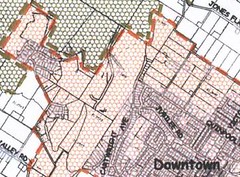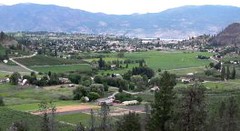Cartwright Vistas and 53 Hectares of ALR
 I'm a bit of a map junkie, and I was looking at OCP maps again tonight. My eye kept returning to one area. This graphic shows a small section of the Urban Growth Area Map proposed in Draft 2 of the OCP that I think we should be paying more attention to.
I'm a bit of a map junkie, and I was looking at OCP maps again tonight. My eye kept returning to one area. This graphic shows a small section of the Urban Growth Area Map proposed in Draft 2 of the OCP that I think we should be paying more attention to. Here's why:
- The pink/red shows existing development and areas slated for development in the near future (before anything in the Future Growth Area is developed), so we're not talking about the distant future.
- It contains the 53-hectare block of ALR land to the north of the downtown core that will likely be controversial. Is it close enough to downtown that residents will actually choose to walk to Giant Foods? Probably not, but it's the closest "available" land to the commercial centre.
- Look closely at how much of Cartwright Mountain is slated for immediate development -- everything west of Cartwright Ave. It's a huge area and much of the east side is visible from everywhere in town. The potential for a Westbank-style clearcut 'n gouge hillside development is just a little too scary.
- Don't think they'll allow an ugly and illogical hillside development on Cartwright? Then ask yourself this -- why on earth did they allow Deer Ridge to be constructed with no sewer lines anywhere near it? Why didn't the developers have to pay for infrastructure upgrades before plopping a bunch of homes up there? Now we'll all be paying for it, subsidizing their purchases (and profits) from five or ten years ago. At a glance, Cartwright Vistas and North Prairie Valley look like more plans for classic monster-home sprawl.
Oh, and the Jersey Lands show up as a bizarre and disconnected block of pink nowhere near any serviced areas, totally stranded out there on the side of Conkle Mountain. It obviously has no business being part of the Urban Growth Area for Summerland, and maybe not even the Future Growth Area. I have no idea what they were thinking -- the costs of creating the necessary infrastructure should be prohibitive.
Finally, take another look at the full map and try to figure out why the proposed golf course way out on the municipal boundary has anything to do with coherent and logical regional planning. It could almost be hilarious if it wasn't so serious.


5 Comments:
Not only that, but Cartwright Mtn. is habitat for wildlife and plantlife. And the south Okanagan is an endangered ecosystem.
See these two links:
http://www.ec.gc.ca/science/sandenov00/article2_e.html
http://www.obtwg.ca/reg_description.html
IMO, I would rather see habitat—and the species within—protected than farmland. Farms and orchards, because of heavy pesticide use, are nearly sterile environments. Residential developments, when properly landscape, will support far more species than an orchard, but much less than actual wild habitat.
For me, species unique to the Okanagan trump apple and cherry trees.
P.S. The first url above might be too long. If so, use this one:
http://tinyurl.com/3lbos
By Anonymous, at 11:50 p.m.
Anonymous, at 11:50 p.m.
April 1/2005
Unfortunately, Anonymous, we don’t live in the Garden of Eden or even Utopia. I don’t know what you do for a living, but next to nurses and doctors, the most respected occupation happens to be farming. Whether we produce milk, meat, apples or cherries we can take pride in the fact that we are producing something that you can’t do without. I’m an orchardist who grows apples and have for the last 35 years. Now you can live without apples, but I doubt that you do. You can also live without grapes and without the grains that produce beer, but unless you are a teetotaller I imagine you have probably indulged in both wine and beer lately. Most of us are not organic growers, and that is a pity. But you won’t find many big organic growers of animals or grains or fruit. But, with the exception of grow op culturalists, most of us are just as environmentally concerned as you are. I try to do my bit. I spent over $500 dollars this past winter on bird feed. I have over 15 birdhouses around the periphery of my orchard. We enjoy hummingbirds immensely and have a number of feeders out for them. In turn, the quail that I feed provide food for eagles and hawks and other predators, including coyotes. Unfortunately, because of dozens of deer in my orchard at a time I have had to put a fence around it. But that doesn’t make me anti-environmentalist. I believe I have far more birds per square foot of land than any local home and lot, because there is far more food available here than in the average back yard. And we also have moles, voles, mice and packrats, which are also part of nature’s retinue. The bees that we bring in for pollination perhaps pollinate the flowers in your backyard.
I could continue this “lecture”, however, I think you get the idea. There are far more people who do harm to nature than farmers and orchardists, in general. “Let he who is without sin cast the first stone.”
By Anonymous, at 8:54 p.m.
Anonymous, at 8:54 p.m.
So you would prefer to destroy the natural habitat on Cartwright Mtn. that supports native species rather than develop existing farmland?
We have more than enough farmland in North America. And agricultural practices are increasingly efficient and productive so that we get higher yields from smaller plots of land.
But once you convert wilderness to farmland, the wilderness is essentially lost forever. How much remains of the original prairie? Less than 5% and many species are extinct from the prairie.
We can protect both farmland and wildnerness in the Okanagan if we stop people moving here. But that's not going to happen. So what else can we do? Just build vertically and let newcomers live in high-rises. That won't work either. Development and expansion in the Okanagan is inevitable, and it poses a threat to both farmland and wilderness because the land has to come from somewhere. Personally, I'm willing to sacrifice a portion of the farmland in order to protect habitat in an endangered eco-system. It'd be nice if we didn't have to do either, but we don't have that choice.
By Anonymous, at 12:00 a.m.
Anonymous, at 12:00 a.m.
Anyonymous 1, I share your concern for the preservation of current wilderness and mountain ecosystems surrounding Summerland. In fact, I'm probably more passionate about that issue than any other in town, but it's hardly come up here.
That said, please don't fall into the trap of assuming that we have to choose one or the other. Our existing greenspace on Summerland's Big Four (Giant's Head, Conkle, Cartwright, and Rattlesnake) is as worthy of protection and care as our agricultural land. They're equally important for different reasons.
Also, I'd encourage you to sign your name at the bottom of your comments -- it's just too easy to hide behind anonymity.
By Jeremy, at 9:21 p.m.
Jeremy, at 9:21 p.m.
Anonymous 2, I hope you're not trying to defend modern farming practices in North America. The industrial-model monoculture being practiced right now is obviously not sustainable -- it requires immense inputs of chemical fertizilers and every kind of nasty -cide to grow anything in our damaged soils.
You wrote: "Just build vertically and let newcomers live in high-rises. That won't work either."
That's exactly what they're starting to do in Kelowna now, although not all in high-rises -- they're working on increasing the density of existing residential and mixed-use areas to take the pressure off development on the fringes, mostly with multi-level condos and townhouses. That's probably not a bad thing, especially in increasing the number of residents living downtown where they won't be dependant on their cars and can support downtown businesses by walking.
I also utterly reject your theory that we have to choose to destroy either agriculture land or wilderness, with no other alternative. If demand was high enough, and there was a coherent vision for infilling and making our existing areas more dense (particularly downtown with more mixed-use development), we could easily add several thousand people to Summerland over the next couple of decades without sprawling out over the hillsides or orchards.
There will continue to be demand for housing in desirable places up and down the Okanagan, but that doesn't mean that we are powerless to find ways to protect what is most valuable about Summerland.
Does that mean less room for new cul-de-sacs and monster homes? You bet. Buyers of those unsustainable forms of housing are welcome in Westbank, as I'm sure you've seen from the highway.
Oh, and please sign your comments. I like this discussion, but it seems a little weak to not be willing to stand behind your opinions.
By Jeremy, at 9:40 p.m.
Jeremy, at 9:40 p.m.
Post a Comment
<< Home